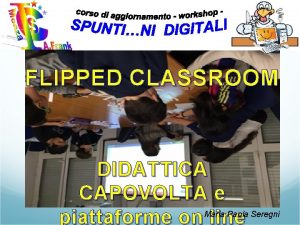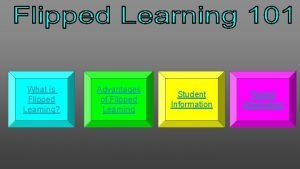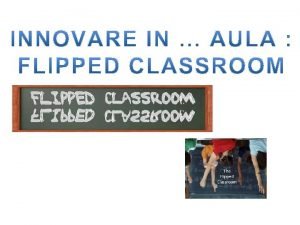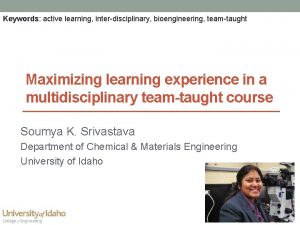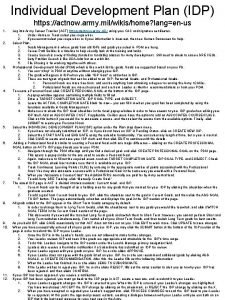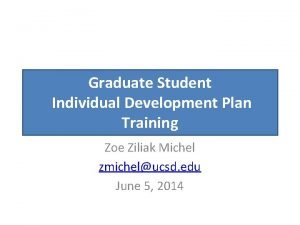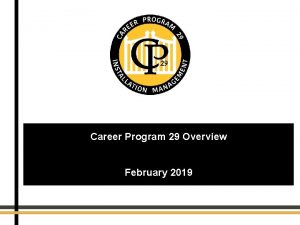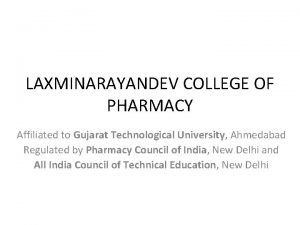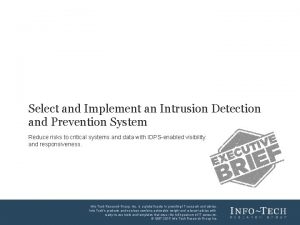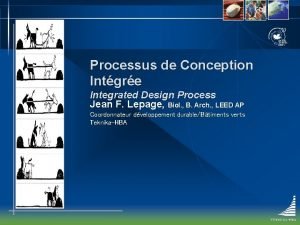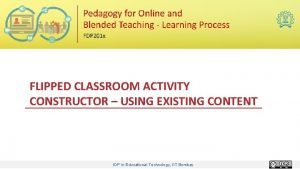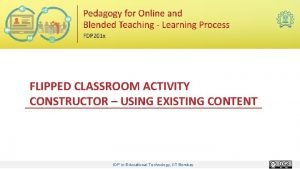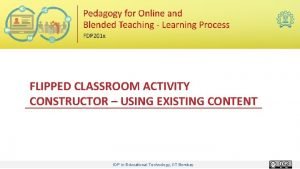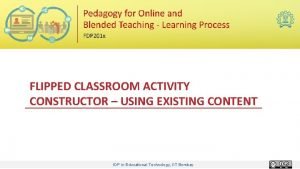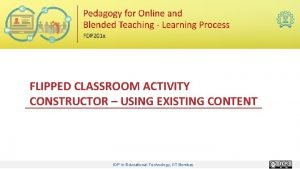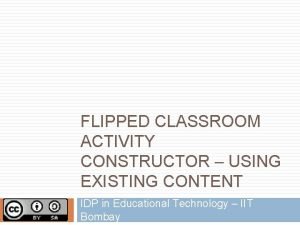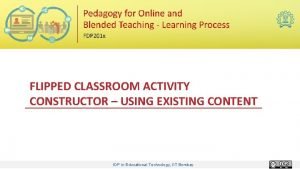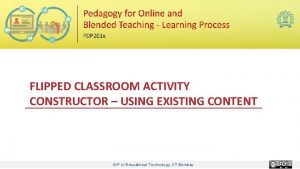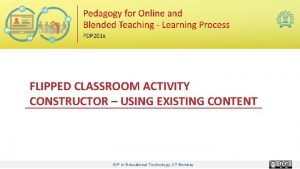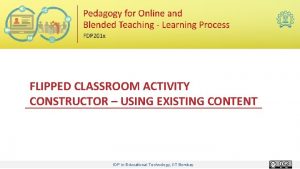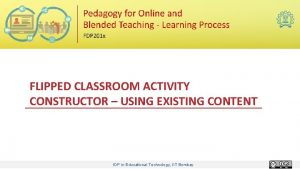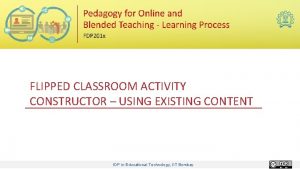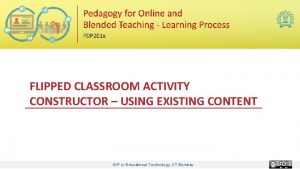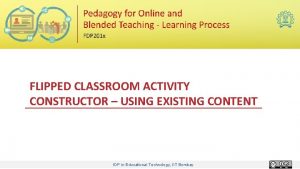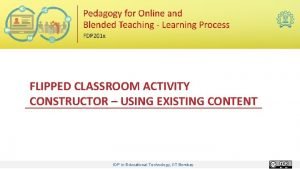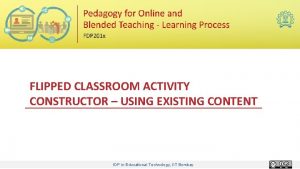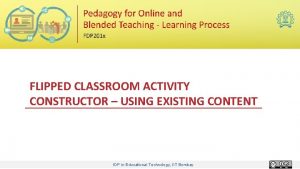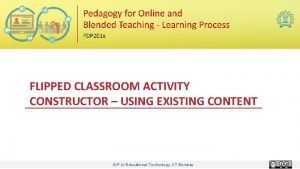FLIPPED CLASSROOM ACTIVITY CONSTRUCTOR USING EXISTING CONTENT IDP



















- Slides: 19

FLIPPED CLASSROOM ACTIVITY CONSTRUCTOR – USING EXISTING CONTENT IDP in Educational Technology, IIT Bombay

Table of Contents SECTION SLIDE # ABOUT ME 3 OUT-OF-CLASS SEGMENT IN-CLASS SEGMENT 5 10 IDP in Educational Technology, IIT Bombay 2

About you Name : Prof. Dr. G. A. Patil Designation : Professor (HOD) Qualification : Ph. D Experience : 25 Yrs. Institute : DYPCET Topic for Flipped Classroom: Networking - Topologies IDP in Educational Technology, IIT Bombay 3

Mandar K Topic: Networking Course : Computer Sci. & Allied Domain : Computer College : DYPCET Target Audience : SE Students of CSE IDP in Educational Technology, IIT Bombay 4

Out-of-class Activity-1 Learning Objective(s) of Out-of-Class Activity At the end of watching the videos student should be able to • • • Understand the various Network Topologies and its types used in networking (Understand Level) Advantages & disadvantages of bus, ring, mesh and tree Topology (Understand Level) Setting up ring topology in the practical view (Apply Level) Key Concept(s) to be covered • • • Network Topologies. Advantages & disadvantages. Practical Implementation. IDP in Educational Technology, IIT Bombay 5

Out-of-class Activity-2 • Video Source URLs: https: //youtu. be/NSHj 9 BLnhj 0 CONCEPT • License of Video : CC VIDEO SEGMENT DURATION (in min) V 1 – 0. 59 to 05. 09 5. 9 V 2 – 05. 16 to 11. 10 6. 06 Star Topology V 3 – 17. 22 to 21. 37 4. 15 Hybrid Topology V 4 – 21. 42 to 22. 03 1. 00 Ring Topology V 5 – 22. 06 to 30. 05 7. 09 Token Ring V 6 – 30. 12 to 35. 50 5. 38 Mesh Topology V 7 – 38. 55 to 40. 35 1. 08 Advantages and Disadvantages to topologies V 8 – 40. 41 to 41. 54 1. 13 Bus Topology Time Duration: 41. 54 min IDP in Educational Technology, IIT Bombay 6

Out-of-class Activity-3 • Video Source URLs: 1. https: //www. youtube. com/watch? v=F 35 s. SPTah. S 8&t=211 s 2. https: //www. youtube. com/watch? v=l. Zv. ILl 4 r. Y 2 o 3. https: //www. youtube. com/watch? v=VIv. Hg. H 7 e. Ngc • License of Video : Creative Commons Attribution license (reuse allowed) CONCEPT VIDEO SEGMENT DURATION (in min) Network Topologies V 9 – 0. 00 to 05. 07 5. 7 Advantages & Disadvantages of star topology V 10 – 0. 00 to 7. 10 10. 00 Practical Implementation of Ring topology V 11 – 0. 00 to 5. 45 Time Duration: Video 9 : 5. 07 min Video 10 : 12. 32 min IDP in Educational Technology, IIT Bombay Video 11 : 5. 45 min 7

Out-of-class Activity-4 Aligning Assessment with Learning Objective Different topologies used in computer Network Assessment Strategy Q. Explain the following terms: A. Bus Topology B. Star Topology C. Hybrid Topology D. Ring Topology E. Mesh Topology Expected Duration (in min) 10 minutes Additional Instructions (if any) Watch V 1, V 2, V 9 and then answer A Watch V 3, V 9 and then answer B Watch V 4, V 9 and then answer C Watch V 6, V 7, V 9 and then answer D IDP in Educational Technology, IIT Bombay 8

Out-of-class Activity-5 Aligning Assessment with Learning Objective Advantages and Disadvantages of Network Topologies Learning Objective Practical Implementation of Network Topologies Expected Duration (in min) Additional Instructions (if any) 10 minutes Watch V 8, V 10 and then answer Q 1 Expected Duration (in min) Additional Instructions (if any) 7 minutes Watch V 11 and then answer Q 1 IDP in Educational Technology, IIT Bombay 9 Assessment Strategy Q 1. What are the advantages and disadvantages of various network topologies? Assessment Strategy Q 1. How Ring topology is implemented practically? Total activity duration: 27 Min.

In-class Activity-1 Learning Objective(s) of In-Class Activity At the end of the class, students will be able to, • Understand the Various network topologies used in communication. • Advantages and disadvantages of each topology • Practical implementation of ring topology (ANALYZE Level) Ø Ø Key Concept(s) to be covered • Different Network topologies and its advantages and disadvantages IDP in Educational Technology, IIT Bombay 10

In-class Activity-2 Ø Active Learning activity(ies) that you plan to do Real world problem solving using. § Think-Pair-Share Concept clarification using. § Peer Instruction IDP in Educational Technology, IIT Bombay 11

In-class Activity-3 Peer Instruction Strategy – What Teacher Does: • Pose the two PI questions at the start of the class and provide summary of basic identities and expression simplification. Ø Q 1: Which Topology is used college laboratories? A. Star Topology B. Mesh Topology C. Bus Topology D. Hybrid Topology IDP in Educational Technology, IIT Bombay 12

In-class Activity-4 Peer Instruction Strategy – What Teacher Does Q 2: Data communication system spanning states, countries, or the whole world is a) LAN b) WAN c) MAN d) None of the mentioned Q 3: This topology requires multipoint connection a) Star b) Mesh c) Ring d) Bus IDP in Educational Technology, IIT Bombay 13

In-class Activity-5 Peer Instruction Strategy – What Student Does § § § For each question they will first vote individually. Then they will discuss with peers and come to consensus. Listen to instructors explanation. IDP in Educational Technology, IIT Bombay 14

In-class Activity-6 • TPS Strategy – What Instructor does First provide a premise Ask the students about network. Which type of Network is used to connect two buildings? Why it is used? What are the advantages and disadvantages of various network topologies? Now let the students think on this questions among themselves IDP in Educational Technology, IIT Bombay 15

In-class Activity-7 TPS Strategy – What Instructor does Think (~2 minutes) Instruction: • The network type may be LAN, MAN, WAN • If we use mesh topology in laboratories what happens? Think individually and identify the scenario. IDP in Educational Technology, IIT Bombay 16

In-class Activity-8 TPS Strategy – What Instructor does Pair (~5 minutes) Instruction: Now pair up and compare your answers. Agree on one final answer. While students are pairing and discussing, instructor goes to 2~3 sections to see what they are doing. IDP in Educational Technology, IIT Bombay 17

In-class Activity-9 TPS Strategy – What Instructor does Share (~8 minutes) Instructor asks a group to share their answer with class and see whethere are different answers. After sharing is done, instructor gives feedback on the correct solution IDP in Educational Technology, IIT Bombay 18

In-class Activity-10 Justify why the above is an active learning strategy In both the above strategies, students are required to go beyond mere listening and execution of prescribed steps. They are required to think deeply about the content they were familiarized in out-of-class and do higher order thinking. IDP in Educational Technology, IIT Bombay 19
 Paola seregni
Paola seregni Flipped classroom disadvantages
Flipped classroom disadvantages Venitemi dietro con l'occhio significato
Venitemi dietro con l'occhio significato Meg moodle
Meg moodle Flipped classroom schema
Flipped classroom schema Bioengineering active learning
Bioengineering active learning Flipped classroom
Flipped classroom Flipped classroom model
Flipped classroom model Flipped classroom pros and cons
Flipped classroom pros and cons Act now army
Act now army Idp examples
Idp examples Army setm
Army setm Srx idp configuration
Srx idp configuration Bosch accredited contractor
Bosch accredited contractor Glipmpse
Glipmpse Lanfh
Lanfh Idp vsko
Idp vsko Idp vendor landscape
Idp vendor landscape Idp coop
Idp coop Integrated design project civil engineering
Integrated design project civil engineering
